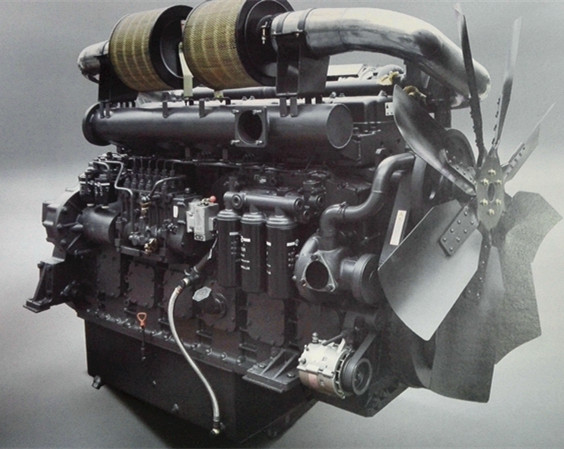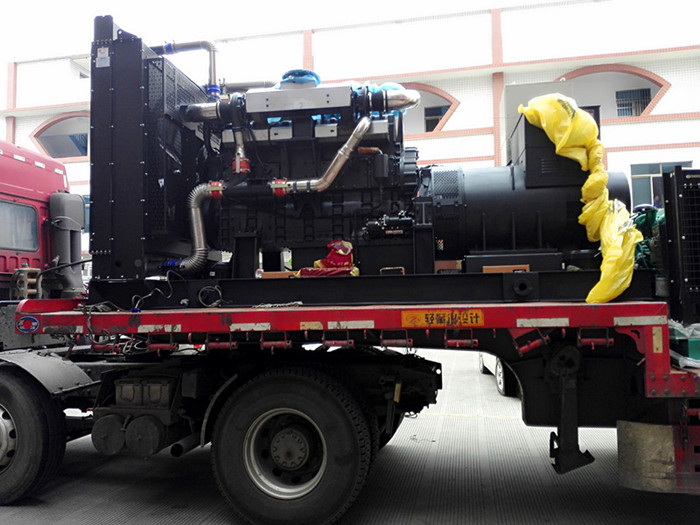4. Operation Instructions - Shangchai W Series Diesel Engine
Proper use of your engine can not only keep it in normal working order and good performance, but also extend its service life and reduce its operational cost. Adopt proper fuel, oil and coolant as well as the correct operation steps stipulated in this section.

4.1 Diesel fuel
Proper diesel fuel designation should be chosen for the engine according to ambient temperature. In cold winter, fuel with low-freezing-point should be adopted, while contrary in summer. You may choose the right fuel according to the standards GB252-2011 or refer to the table below, e.g. the fuel in grade of-10 should be used at the ambient temperature of -5℃.
Relationship between diesel fuel designations and applicable minimum temperatures
Fuel Grade | 0 | -10 |
Cetane number | ≥45 | ≥45 |
Solid point, ℃ | ≤0 | ≤-10 |
Minimum applicable temperature (engine working temperature), ℃ | Above 4℃ | Above -5℃ |
The specifications of the fuel used for the engine should be in accordance with the standards GB252-2011 General Diesel Fuels.
Specifications of fuel in the designation of 0 and -10
Item | Requirement | Requirement |
Fuel designation | 0 | -10 |
Cetane number | ≥45 | ≥45 |
Distillation 50%, ℃ 90%, ℃ 95%, ℃ | ≤300 ≤355 ≤365 | ≤300 ≤350 ≤365 |
Kinematic viscosity @ 20℃: mm2/s | 3.0-8.0 | 3.0-8.0 |
10% carbon residue, % (mm) | ≤0.3 | ≤0.3 |
Ash, % (mm) | ≤0.01 | ≤0.01 |
Sulfur, % (mm) | ≤0.2 (before June 30, 2013) ≤ 0.035 (after July 1, 2013) | ≤0.2 (before June 30, 2013) ≤ 0.035 (after July 1, 2013) |
Mechanical impurity | None | None |
Moisture (V/V), % | Trace | Trace |
Plash point (close), ℃ | ≥55 | ≥55 |
Sheet copper corrosion test (@ 50℃ for 3h), class | Lower than class 1 | Lower than class 1 |
Acid, mgKHO/100ml | ≤7 | ≤7 |
Solidifying point, ℃ | ≤0 | ≤-10 |
Condensation point, ℃ | ≤4 | ≤-10 |
Water soluble acid or alkall | None | None |
Oxidation stability in terms of total insoluble matter, mg/100 ml | ≤2.5 | ≤2.5 |
Caution: Fuel must be kept at the highest level of cleaness and not polluted by dust, impurities or water.
4.2 Engine oil
To ensure normal operation and long service life of the engine as well as improve engine emissions, it is recommended to use SDEC's special lube oil of CF-4 15W-40. lf it Is not available, the lube oil of CF 30 or CF 40 that meets national standard (GB 11122) may be used or CD 15W-40 that meets national standard (GB 11122) may be used provided that oil temperature will be controlled no higher than 110℃.
Caution: Lubricating oil must be kept clean and free from dust, impurities or water.
Caution: Do not use the mixture of oil of different specifications.
4.3 Coolant
In order to ensure the normal operation and long service life of the engines, use SDEC-designated special organic coolant (anti-freezing type) under any kind of climate. The coolant proves antifreeze, anti-corrosion, good thermal conductivity, performance stability, and environmental friendliness.
Name | Part No. | Freezingpoint/℃ | Boiling point/℃ |
SDEC-designated special organic coolant | F/LQY-45 | -45 | 108 |
Caution: Do not use raw water to cool the engine directly.
4.4 Power Matching
When choosing a diesel engine, users should not only consider the power required by equipment to be driven, but also engine operation type, such as intermittent use or continuous use. Meanwhile, operational economy is an important item to be considered that is, the characteristics of equipment load and engine power output must be reasonably matched. Correct power rating and reasonable match between engine power output and equipment load are essential to guarantee a reliable, long-life and economic operation of an engine. Otherwise,it would lead to overloaded operation and unnecessary failure of an engine. Or load is too small and the capacity of an engine cannot be fully used, which is not an economic way to use an engine and also easy to lead to oil carry-over.
4.5 Engine Start
Before using the engine, choose proper lubricating oil, fuel and coolant according to ambient conditions. Besides, the following work should be done before starting:
● Make a surround inspection of the engine and its starting system, and solve problems in time if any.
● Check oil pressure and temperature gauges, coolant temperature gauge, warning rights and other instruments for normality.
● Check whether the air filter is clogged.
Caution: Do not to start the engine without an air filter to avoid early engine wear. Marine application is exceptional.
● Check the oil level for being within the specified range.
● Check the oil level in the fuel pump for being within the specified range.
● Check the coolant level for being within the specified range.
● Check the electrolyte level for being within the specified range.
● When the, engine is first put into use or is out of service for some days, or its fuel filter has just been replaced, there can be air in the fuel system, Prime the fuel system with the priming pump. Refer to section 5.3 for specific priming
operation.
● Check the electric starting wires for normality.
● Check the starting motor for right wire connection, and battery for sufficient electricity.
● All the safety devices must be installed in place.
● Check the accelerator lever and stopping lever for free movement.
● Discharge remaining oil in the new engine if any.
● When the engine is new or is not in use for over 5 days, rotate the crankshaft 3 to 5 circles before starting.
4.5.1 Normal starting procedure
The W series diesel engine can be started smoothly at temperature of 5℃and above. Starting procedure is as follows:
● Disengage the diesel engine from the drive system.
● Put the mechanical operating devices into the “running” position.
● Start the electric oil pump to pre-supply oil and make the pressure of the oil in the main gallery reach 100kPa.
Caution: Do not start the engine until the pressure of the oil in the main gallery reaches 100kPa.
Caution: the electric pump should not work continuously over 20 seconds.
● Press the electric button and control the governor handle until a continuous poop is heard, and then release the button immediately, and adjust governor handle to let engine run at idle speed.
Caution: The engine should be started without load.
Caution: Each starting should not last over 10 seconds and there should be a two- minute interval between each starting.

● Having started up from a hot state, the engine should run at idle for 3–5 minutes before being accelerated and loaded gradually.
● Having started up from a cold state, the engine should run at idle for 5–10 minutes for warm up until the oil pressure reaches 0.4 MPa, the outlet coolant temperatures is higher than 55℃ and the oil temperature reaches 45℃.Check all the instruments for morality, as well as the engine and its external pipeline for seal condition, and observe the engine and turbocharger for operational noise and for engine smoke. Stop the engine immediately for inspection in case of any abnormality. The engine should be warm up completely before being accelearated and loaded gradually.
● Do not run the engine with full load until the outlet coolant temperature is higher than 75℃, oil temperature 60℃and oil pressure 0.40 MPa.
Caution: Especially starting the engine from a cold start, increase the engine speed or/and load slowly as far as possible to have every bearing adequately lubricated and oil pressure stable.
Caution: Do not accelerate and load the engine immediately after it has been started up.
Caution: Do not idle the engine for a long period of time or it can cause problems to the engine. When an engine idles, the temperature in combustion chamber is low and combustion is not complete. It can cause carbon deposit in cylinder resulting in block of the orifices of fuel injector, as well as seizures of rings and valves, thus leading to engine performance deterioration.
Caution: If the engine is start by a jumper cable, parallel connection of the cable should be adopted by connecting the positive pole to the positive terminal and the negative pole to the negative terminal. If the engine is start by external power supply, the circuit breaker should be set to the position OFF. Take out the key to prevent accidental activation before the connection of jumper cable.
4.5.2 Cold start
When ambient temperature is below 50°C, heat the engine oil and coolant first till the oil temperature rises to 40°C and outlet coolant temperature to 30°C while doing the above preparation, and then follow the normal starting procedure to start the engine.
4.5.3 Starting after a long-time stop or replacement of lubricating oil
If the engine hasn’t been used for more than 30 days or its engine oil has just been replaced, it is necessary to fill the lubricating system with oil. Crank the engine and make oil enter moving parts. Start the engine only after you feel light when cranking the engine. Finish the following preparation before starting the engine according to the procedures of normal starting or cold starting:
● Check the oil level for being within the dipstick marks range.
● Check the voltage of the battery for abnormality.
● Prime the fuel system, Refer to Section 5.3 for operation.
In order to have a quick starting of a standby engine for emergency need, start the engine every three to five days and operate it until its engine oil and coolant temperature reaches 60°C and above.
Copyright © Guangxi Dingbo Generator Set Manufacturing Co., Ltd. All Rights Reserved | Sitemap
Update cookies preferences